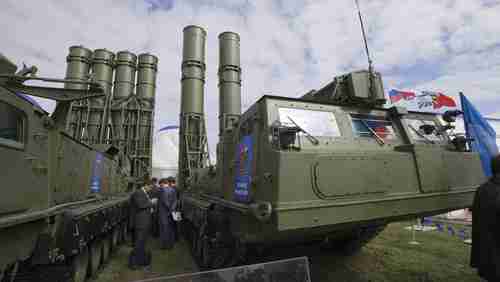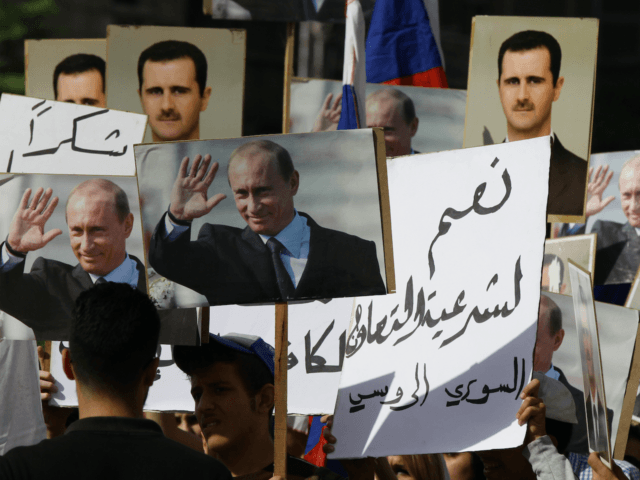This morning’s key headlines from GenerationalDynamics.com
- Russia continues large air defense military buildup in Syria
- Concerns about possible US-Russia military conflict continue to grow
Russia continues large air defense military buildup in Syria

Russian S-300 air defense missile system (AP)
Russia announced in April that it had met its objectives in Syria, and its military was withdrawing. Then, as the army of the regime of Syria’s president Bashar al-Assad began collapsing again, Russia changed its mind. Russia’s increasing military buildup in Syria indicates that it has no intention of withdrawing, and may even be treating Syria as a part or a protectorate of the Russian federation.
Russia’s military on Tuesday announced that a battery of the S-300 air defense missile systems had been sent to Syria. This follows installation of a long-range S-400 missile defense system, and an array of other surface-to-air missiles. These have raised concerns among analysts, to which Russia’s Defense Ministry responded: “I remind you that the S-300 is a purely defensive system and poses no threat to anyone. It’s not clear why the placement of S-300 in Syria has caused such a stir among our western colleagues.”
No jihadist group has an air force, so the deployment of advanced air defense missile systems must be directed at someone else. There are several possibilities:
- Russia is about to conduct some new military action in Syria, and does not wish to risk an American military response.
- Syria is becoming essentially a part of the Russian federation, and Russia is turning it into a permanent military base.
- Russia is preparing for war with its historic enemy, Turkey.
Military Times and AFP
Related Articles
- Russia declared ‘Mission complete’ in Syria and withdrew, but the war rages on (05-Apr-2016)
- US, UK, UN officials accuse Syria and Russia of barbarism and war crimes (27-Sep-2016)
Concerns about possible US-Russia military conflict continue to grow
Many analysts are concerned that Russia’s military buildup in Syria means that Russia and the United States are headed for a military conflict when the next American administration takes office in January. I wrote about these concerns several days ago.
However, long-time readers know that Generational Dynamics predicts that Russia, Iran and India will be allies of the West in the approaching Clash of Civilizations world war against China, Pakistan, Saudi Arabia and the Sunni Muslim countries.
Europe’s last three generational crisis war all involved an invasion of Russia, but they were crisis wars for Europe, but non-crisis wars for Russia:
- The War of the Spanish Succession (1701-14) was a generational crisis war for Europe and for Sweden in the Great Northern War with Russia (1700-20), but it was a non-crisis war for Russia.
- The Napoleonic Wars (1800-1814) were a crisis war for France, which invaded Russia, but it was a non-crisis war for Russia.
- World War II (1939-45) was a generational crisis war for Europe, and for Germany, which invaded Russia, but it was a non-crisis war for Russia.
These were brutal wars for Russia, but a component of the war was that invading armies were defeated by the brutal Russian winter.
Russia’s generational crisis wars were not fought with Europe. They were either internal rebellions, or they were fought with Turks and Mongols. Of particular importance were the Tatars, a tribe of Mongols that, under the leadership of Genghis Kahn, probably the greatest conqueror in the history of the world, they had defeated China in 1215, and then turned westward and conquered much of southern Russia by 1227. The Tatars in the Crimean Peninsula had intermingled with the central Asian Turks, and spoke a Turkic language. By the 1400s, they adopted Islam as their religion. It was in 1571 that the Crimean Tatars attacked and sacked Moscow, then ruled by Ivan the Terrible.
Russia under Catherine the Great fought a generational crisis war with the Ottoman Empire from 1762-83. Russia fought the Ottomans again under Tsar Nicholas I in the Crimean War in 1853-55. World War I was a generational crisis war for both Russia and Turkey, and it saw the destruction of both Tsarist Russia (Bolshevik Revolution) and Ottoman Turkey.
So Russia’s great historical generational crisis wars have been not with the West, but with the Ottoman Turks, the Mongols, and the Crimean Tatars. And that’s the way it’s going to be in the next war as well.
Related Articles
- Turkey shoots down Russian warplane, evoking memories of many Crimean wars (25-Nov-2015)
- Concerns growing of a military showdown between US and Russia in Syria (02-Oct-2016)
- Hard issues prevent full reconciliation between Turkey and Russia (08-Jul-2016)
KEYS: Generational Dynamics, Russia, Syria, Bashar al-Assad, S-300, S-400, Clash of Civilizations, Turkey, China, Pakistan, Saudi Arabia, War of the Spanish Succession, Sweden, Great Northern War, Napoleonic Wars, France, World War II, Germany, Crimea, Tatars, Mongols, Turks, Genghis Khan, Catherine the Great, Ivan the Terrible, Ottoman Empire, World War I, Bolshevik Revolution
Permanent web link to this article
Receive daily World View columns by e-mail

COMMENTS
Please let us know if you're having issues with commenting.